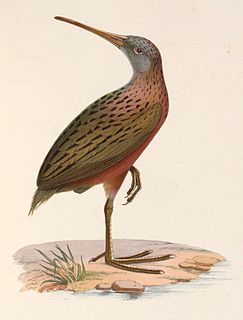
Sanzinia madagascariensis, also known as the Malagasy tree boa, or Madagascar tree boa) is a non-venomous boa species endemic to the island of Madagascar. It was considered conspecific with the Nosy Komba ground boa.

Acrantophis madagascariensis is a species of boid snake in the subfamily Sanziniinae that is endemic to the island of Madagascar. Its common names include Malagasy ground boa and Madagascar boa.

The Far Eastern curlew is a large shorebird most similar in appearance to the long-billed curlew, but slightly larger. It is mostly brown in color, differentiated from other curlews by its plain, unpatterned brown underwing. It is not only the largest curlew but probably the world's largest sandpiper, at 60–66 cm (24–26 in) in length and 110 cm (43 in) across the wings. The body is reportedly 565–1,150 g (1.246–2.535 lb), which may be equaled by the Eurasian curlew. The extremely long bill, at 12.8–20.1 cm (5.0–7.9 in) in length, rivals the bill size of the closely related long-billed curlew as the longest bill for a sandpiper.

The red fody, also known as the Madagascar fody in Madagascar, red cardinal fody in Mauritius, or common fody, is a small bird native to Madagascar and introduced to various other islands in the Indian Ocean. It is a common bird within its restricted range, and the International Union for Conservation of Nature has assessed its conservation status as being of "least concern".

Several species of Malagasy hippopotamus lived on the island of Madagascar but are now believed to be extinct. The animals were very similar to the extant hippopotamus and pygmy hippopotamus. The fossil record suggests that at least one species of hippopotamus lived until about 1,000 years ago and other evidence suggests that the species may have survived until much more recently. A non-fossilized skull and tusk were found in Madagascar in 2019 by biologist Forrest Galante and primatologist Cortni Borgerson, and were dated to less than 200 years old, possibly even surviving into the present day. The taxonomy of these animals is not resolved and not widely studied. The various species are believed to have survived into the Holocene epoch.

The Madagascar rail is a species of bird in the family Rallidae.

Typhleotris madagascariensis is a species of fish in the family Milyeringidae that is endemic to Madagascar, where it is only known from underground waters in the southwestern portion of the island. This cavefish is blind and lacks pigmentation, and can reach a standard length of 8 cm (3.1 in).
Tropodiaptomus burundensis is a species of calanoid copepod in the family Diaptomidae.
Tropodiaptomus is a genus of copepods in the family Diaptomidae. It includes the following species, many of which are narrow endemics and are included on the IUCN Red List :
Tropodiaptomus ctenopus is an extinct species of calanoid copepod in the family Diaptomidae.
Tropodiaptomus falcatus is a species of calanoid copepod in the family Diaptomidae.
Tropodiaptomus kilimensis is a species of calanoid copepod in the family Diaptomidae.
Tropodiaptomus kissi is a species of calanoid copepod in the family Diaptomidae.
Tropodiaptomus neumanni is a species of calanoid copepod in the family Diaptomidae.
Tropodiaptomus simplex is a species of calanoid copepod in the family Diaptomidae.
Tropodiaptomus stuhlmanni is a species of calanoid copepod in the family Diaptomidae.
Tropodiaptomus worthingtoni is a species of calanoid copepod in the family Diaptomidae.

Mangerivola Special Reserve is a wildlife reserve in the east of Madagascar. It was established in 1958 and is a hotspot for bird-watchers due to the one hundred species found there, including 63 endemics and many local endemics. There are also seven species of lemur and rare chameleons such as the Lance-nosed chameleon which is registered as endangered on the IUCN Red List of Threatened Species.
Petchia madagascariensis is a plant in the family Apocynaceae.







